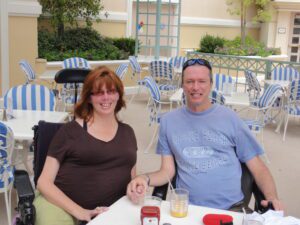Ray Jordan and Cyndi Segroves were born thousands of miles away from one another; in fact, they grew up in different countries. Cyndi is from the US and Ray is from Australia. But their lives were brought together by the rare disorder that they both shared: facioscapulohumeral muscular dystrophy (FSHD).

About Facioscapulohumeral Muscular Dystrophy
Facioscapulohumeral muscular dystrophy (FSHD) is a rare, inherited type of muscular dystrophy that is characterized by typically affecting the muscles of the face, upper arms, and shoulders first before progressing to other areas of the body. There are two variants of facioscapulohumeral muscular dystrophy that are linked to abnormal expression of a gene called DUX4. Symptoms typically begin to appear in childhood and become more pronounced in the teenage years. Other muscles also become affected, and the progression of muscle atrophy is usually asymmetrical. Symptoms include weakness of facial muscles, a fixed facial expression, difficulty raising the arms and moving them when raised, foot drop, problems with breathing, generalized muscle weakness, and hearing loss. There is currently no treatment specifically approved for facioscapulohumeral muscular dystrophy. Common interventions include mobility aids, cognitive behavioral therapy, occupational therapy, physical therapy, and, in some cases, surgery. Life expectancy can be affected when the breathing muscles begin to decline. To learn more about facioscapulohumeral muscular dystrophy, click here.
Cyndi and Ray’s Story
Cyndi was in her early teens when she started to have difficulty raising her arms, which is an early sign of FSHD. After years of visiting different doctors and undergoing a variety of evaluations, she was officially diagnosed right before she turned 16. Ray also noticed some abnormalities as a child and teen, such as protruding shoulder blades and problems raising his arms. Ray said he tried to ignore his differences and it wasn’t until age 34, when he started having trouble with coordination and arm strength, that he visited a doctor and was diagnosed by a neurologist.
Cyndi and Ray both eventually got involved with the FSH Society (now known as the FSHD Society). Cyndi was also beginning her work as an advocate and began writing about issues relevant to people with disabilities. She began reaching out to others in the group’s Facebook page, and Ray accepted her friend request. The two began messaging about Cyndi’s articles and met in person for the first time in Las Vegas in 2010.

“I had started writing for an online newspaper that focused on the disabled community. We started chatting about one of my articles through messenger in 2009. About ten months later we met in person.” – Cyndi
Ray and Cyndi were both travelers and continued to see one another for the next few years, and by 2016 they were married. They have since become a pillar of the FSHD patient community. Ray and Cyndi have been active participants in many research studies, fundraisers, and surveys over the years.
Even during the pandemic, which shut down a lot of in person events, the two participated in the annual FSHD Society Walk and Roll, doing laps around the house. Ray and Cyndi also announce their travels on social media and host community meetups with other patients, often meeting up for a meal or a drink. The couple live active and fulfilling lives and have steady careers that have allowed them to continue working through COVID-19. Ray co-owns a business that manufactures and transports parts for bowling machines; Cyndi works for a software company.
“We both use powered wheelchairs and have been able to live much of our lives independently. Life doesn’t come to an end when you become disabled. It isn’t always easy, but it is doable…we’re lucky that we’ve had time to learn how to take care of ourselves. For us, life is good.” – Ray
To learn more about the FSHD Society, click here.


